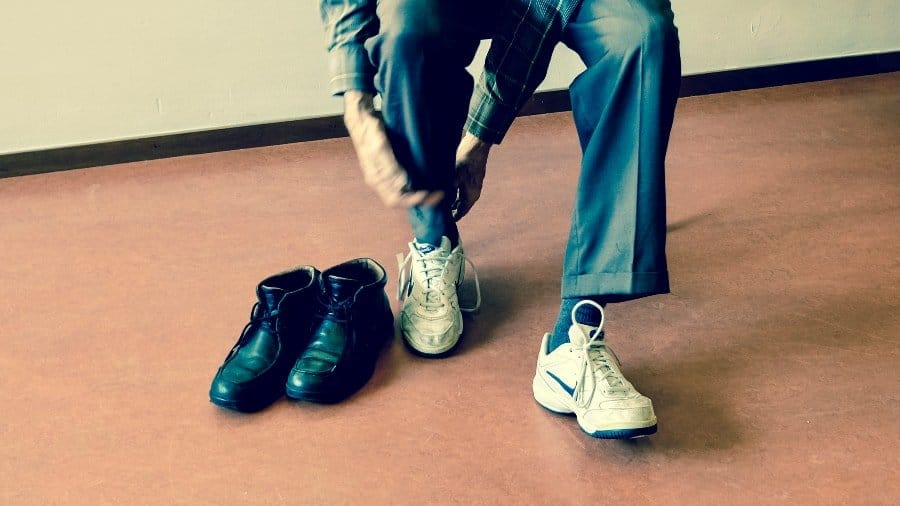Disclosure: This page may contain affiliate links, meaning we receive a commission if you decide to make a purchase through our links, but this is at no additional cost to you. Please read our disclosure and privacy statement for more info.
A swing shift means different things to different people or well, to different employers anyway. Nurses might work an 8-hour shift starting at odd times, 3pm-10pm, for example, while pilots and flight attendants have it even more complicated, because their shifts can last anywhere from 5-15 hours and start literally any time of day, meaning they’re always working a swing shift.
A “swing shift” can be any non-traditional shift that overlaps with traditional shifts to ensure that an industry can run smoothly and account for shift changes without coming to a grinding halt. Most industries that operate 24/7 will have some form of swing shift.
If you happen to work in one of these industries that never sleep, you’ll probably have to survive a weirdly timed swing shift at some point. Swing shifts are challenging precisely because they do not adhere to the traditional shift orientations and may even be constantly changing, making it impossible to shape your lifestyle around a normal routine.
We wanted to make your life a little easier, so we decided to share eleven “secrets” to working and surviving a swing shift!
Swing Shift Secret #1: Learn the 24-Hour Clock
This tip is taken straight from our friends in aviation, who, as we mentioned above, pretty much live in a swing shift.
Learning the 24-hour clock will help you keep track of am vs. pm shift times, especially if you are going to be on-call or working an ever-changing schedule.
For example, it is much easier to keep track if we remember our shift is from 17:00 to 01:00, than trying to remember, “do I start at 5pm or 5am today?”
Military time, is often used in shift-work settings because it eliminates the need for AM and PM designations, making it a clearer, more precise way to communicate time. So, if you are new to shift work, it might be good to practice.
It can also be really easy to get discombobulated when you consistently work different, or rotating, swing shifts and you may simply lose track of time, particularly if you work in a windowless environment. Switching your watch, cell phone and alarm clock to 24-hour time will help you know if you are in AM or PM without outside ques.
Pro tip: Aviators also tend to rely on the 24-hour format because it makes it easier to calculate time zone differences. So, if you happen to be traveling for work, or partnering with people in a different time zone, knowing military time will absolutely make your life easier.

Swing Shift Secret #2: Segmented Sleep
“Time isn’t real, but sleep is, so go to bed!”
Spend any amount of time working rotating swing shifts and this quote will begin to resonate with you. It can be really difficult to maintain a consistent sleep schedule when you work a swing shift.
That’s because swing shifts tend to straddle the normal shifts leaving you somewhere in between which leaves you with two issues.
- You are fighting your natural rhythm by staying up late or getting up super early.
- You may not actually get a chance to sleep much before your shift when it starts in the afternoon or early evening.
Segmented sleep may be a way to address these issues because it allows you to get a full 8-hours of rest in a 24-hour period, just not necessarily all at once.
If you work a 19:00 to 03:00 (7pm to 3am) shift, for example, you will probably want to sleep initially when you get home, but maybe you can’t bring yourself to get a full 8-hours because you naturally wake up around 8am. Or perhaps, you have to get up then to get the kids to school leaving you with just 3-4 hours of sleep.
So, instead of getting too little sleep, we encourage you to try segmented sleep. Get your four of sleep hours after work, get up, do what you want / need to do and then go back to sleep when you start to get sleepy again. Get another 3-4 hours of sleep and voila; you have gotten a full 8-hours of high-quality sleep and your batteries were topped of a little closer to your actual shift.
Segmented sleep has historical roots in natural human sleep patterns and may even be more in-sync with our natural body clocks.


Swing Shift Secret #3: Schedule Time to Move Your Body
Exercise is crucial to supporting your immune system, metabolism and sleep cycle; all of which contribute to your overall energy levels. It is important to prioritize active time throughout your day, even if it happens at “weird” times.
Our friends at the Daily Nurse talk about the need for flexibility when you work swing shifts and suggest that you might need to abandon the idea that you have to go to the gym first thing in the morning and be willing to go at night to make it work.
There are a plethora of 24/7 gyms these days, so you really have no excuse not to go. Of course, an added benefit to frequenting the gym during “off hours”, is that you’ll have the place to yourself.
You may also have to buddy-up with someone to motivate yourself to get that sweat-session in. It can be difficult to peel yourself out of bed when you are tired from work, but keep in mind that self-care isn’t always going to come easily.
If you’re thinking of going to the gym after a night shift, check out this article for some things you should remember before gearing up.

Swing Shift Secret #4: Eat Right
Eating healthy, energy-rich foods is key to surviving any shift. But it can be particularly useful when you’re working a swing shift because it will help you boost your energy levels when the body naturally wants to crash; at 3 am, for instance.
We have a number of resources available to help guide shift workers towards healthy nutrition, so here is the spark notes version of our common recommendations.
- Eat a high-protein, carbohydrate-packed meal right before your shift.
- Consume sugar in moderation and always with a protein so you won’t crash.
- Pack your food ahead of time so you won’t be tempted by unhealthy takeout options or vending machine. Not sure where to start in regards to meal prepping? Check out this link
- Eat small, healthy snacks throughout your shift instead of meals to prevent bloating and fatigue.
- Eat something spicy to help perk you up if you feel foggy or drowsy.
- Take notes, if a food makes you feel bloated or healthy, avoid it at work.
Bonus tip: If you do notice that you consistently feel drowsy or nauseated after eating you could have a food intolerance you don’t know about or a blood sugar dysregulation. It might be a good idea to link up with a dietician and see what’s going on.
If you don’t know what to cook, check out this post, which features some of our favorite recipes for shift workers.

Swing Shift Secret #5: Put DOWN that Triple Espresso Cold Brew!
Seriously! Caffeine is not that helpful and should be consumed in moderation. Caffeine can really mess with your energy levels and there are other energy-boosting beverages that might be better to consume at work.
As a rule, do not exceed 400 milligrams (mg) of caffeine per day and do not consume coffee within six-hours of going to bed.
Caffeine has an average half-life of 5 hours, meaning that 50% of the caffeine you consumed is still in your system after 5 hours.
Spoiler alert: Coffee is also dehydrating, so it could contribute to fatigue if you’re not staying hydrated. We’ll talk more about that when we get to our next secret tip.
It is perfectly okay to have a cup of coffee or espresso before your shift, but you will want to taper off your caffeine consumption as your shift progresses. We recommend trying these alternatives:
- Green Tea: You will want to consume green tea in the earlier hours of your shift because it does contain some caffeine, but it is known to help increase focus and decrease inflammation.
- Chocolate milk: Recent studies have discovered that chocolate milk is a better endurance drink than Gatorade and may even rival energy drinks like Red Bull.
- Smoothies: Smoothies can be packed-full of energy-boosting fruits and veggies that will power your body during your shift.
- Ice water: Cold water can be a shock to your senses, which will help perk you up in a pinch.
- Kombucha: Kombucha is a fermented tea, it has low levels of caffeine (less than 25mg), and is full of probiotics. Just know Kombucha does contain trace amounts of alcohol, which could show on those random workplace drug tests if you take swig right before you’re required.

Swing Shift Secret #6: Hydrate
Dehydration is a common source of fatigue and shift workers are at a higher risk of dehydration when they aren’t diligent.
We get it, sometimes you just get so busy you forget to take a drink, which is why we recommend downloading a hydration tracking app that will push reminders to your phone, or smart watch. Hydrillo is free to use, customizable and even compatible with Google Fit and Fit Bit.
It is also important to drink the right things. Not all fluids were created equally for hydrating. Water is naturally, the best thing to drink if you want to stave off dehydration and if it gets boring there are some ways to spice up your water.
The Infuze water bottle, for example, is designed to encourage you to drink more water with two main features.
- It features a flavor cartridge that can be filled with any water enhancer and dialed to control the flavor intensity.
- It has a straw. Which may not seem special, but it has been scientifically proven that you drink more when you use a straw.
Coconut water is also a healthy alternative to plain old H2O and may even help to prevent kidney stones in addition to other health benefits.
If you’re more into the tumbler style drink bottle. We use the BEAST tumbler. Though there are a bunch of others on the market from the likes of YETI and others we like this one. Check out the video below as we explain why.
Swing Shift Secret #7: Strategize Your “Dreaded Hour”
You’ve been working for a while, and you have some time left before the end of your shift, when suddenly time slows way down. Every time you check the clock thinking an hour must have gone by, you realize it has only been three minutes. You lose focus and motivation and begin to wonder how you’re going to make it through the rest of your shift.
Sound familiar? We’ve heard that called the “dreaded hour” in reference to that one hour that just drags by. It might be 3pm or 3am, it might be caused by fatigue or a lull in your workload. Whatever it may be, and whenever it strikes it is good to have a strategy in place to help push through.
When you work swing shifts these moments may hit even harder than when you work a regular shift because you are more likely to be working on your own. Socializing at work may not be bosses’ favorite thing, but it does help keep people alert. Take that away and you’re left with zoned-out swing shift workers.
Each one of us has different “triggers” that help boost our mood and energy, we brainstormed a few.
- Make a playlist: If your employer allows it, (or if you can sneak off for a quick “smoke break”), plug those headphones in and get your toes tapping.
- Take a lap: Take a stroll through the halls, down the aisle (of the airplane that is), or around the block to get your blood pumping, it’ll help to stave off the boredom or fatigue.
- Listen to a podcast: Again, if your employer allows it, listening to a stimulating podcast or audiobook can help keep your brain from idling during a lull or while doing a repetitive task.
- Don’t check the clock: Constantly checking the clock will make time feel like it is passing even slower. Try setting an alarm clock for 30 minuets to an hour and commit to focusing on something until it rings.
- Get an active desk: If you’re mostly office-bound during your shift, then an active desk like this desk bike, might be a great way to combat the dreaded hour.
We wrote a post about what to do on night shift without the internet which might be very useful here. Check it out.

Swing Shift Secret #8: Use Light Therapy
Light therapy could be a strategy to overcome your dreaded hour but there are a number of other benefits including:
- Decreased symptoms of Shift-Work Depressive Disorder
- Increased focus among individuals with Attention Deficit Disorder (ADD)
- Decreased symptoms of Insomnia
- Increased vitamin D production
- Mood improvement
- Decreased symptoms of dementia
- Improved motor function among individuals with Parkinson’s Disease
Light therapy is not a replacement for exposure to real sunlight, but if your swing shift prevents you from seeing much of the light of day, a UV lamp can help make up for the deficit,which as you can see, has its benefits.
Light therapy helps because it works to balance hormones that would otherwise be regulated by your circadian rhythm and your sleep-wake cycle. When that’s out of order, light exposure can trick your body into mimicking light-regulated hormone production.
The best thing about light therapy is, you can take it with you. This portable light therapy lamp is chargeable and provides up to 3-hours of light therapy at your workplace when it is unplugged.

 (click to see on Amazon)
(click to see on Amazon)Swing Shift Secret #9: Create Routine Where You Can
Swing shifts remove us from society’s normal routines and when we combine swing shifts with a rotating schedule we really lose the ability to set up typical habits, but that does not mean we will be totally routine-less.
Even the most chaotic of shift work jobs have their built-in routines. Flight attendants have pre-flight routines that they have to carry out to ensure aircraft and passenger safety. Surgeons have pre-surgery routines to help them prepare for the task ahead.
We can take that same mentality and incorporate some self-made customs into our daily life. Some examples of routines that can be helpful to shift workers include:
- A Pre-Shift Routine: This could be any ritual you use to make sure you’re ready for work. It could be a series of tasks you perform in a certain order to get ready to leave your home and ensure you have everything you need, or it could be a simple meditation.
- A Post-Shift Routine: Do you come home and shower right away, eat some “breakfast” or take the dog for a walk? These things are routines too, and they defiantly aid in winding down after work.
- A Bedtime Routine: This is especially important because you can use this routine to prepare for the next day by laying out your uniform, or making sure your lunch is packed, and with that out of the way you’ll have less to worry about when you’re drifting off to sleep.
- A consistent day off: Having one day off each week can help you to implement some social routines with friends, or help you accomplish administrative tasks, like going to the bank, etc. It might be every Wednesday, but at least that’s something.
Bottom line: Routines are good for our mental health. They help us establish a sense of security, which can be grounding for those of us with highly variable or unordinary swing shift schedules.

Swing Shift Secret #10: Advocate for Yourself
Shift work is demanding, no matter what shift you work, but when you are consistently working rotating swing shifts it is important that you advocate for your own well-being.
Some workplaces have union-negotiated contracts that dictate how much your schedule can move around from one day to the next. Having a full 24-hour period off between opposite shift, for example. (source)
Others have fatigue regulations imposed by outside regulative organizations. The mandate that Flight Attendants get a minimum of 10-hours of rest between duty periods, for example. (source)
In regulated and unionized industries there is often contract language for “rest” and “fatigue” which allows you to articulate that you are no longer capable of safely carrying out the demands of your job, because of those same demands.
This type of union / contract set up is common in the transportation industry, but many railway workers and airline employees note that the company is eager to take advantage of those who don’t read their contract. So, read you contract and be sure to stand up for yourself!
If you are at a workplace that does not have these types of protections, you will likely need to advocate for yourself without backup. In these cases, you can suggest a 6-on-8-off workflow. This allows you to keep a single shift for a whole “block” of six days, followed by 6-8 days off to tend to your life. It creates balance and helps you get into a work-rest pattern that won’t leave you totally wrecked.

Swing Shift Secret #11: Make the Most of Your Time Off
Our last secret has nothing to do with your time at work at all. That’s because striking a work-life balance is really important.
You have to prioritize yourself and make sure you do things that you enjoy in your free time.
And we are not just referring to your days off. The best thing about working a swing shift is that you have time off between shifts that you can make use of too.
Not too many people can go out for a hike before their shift starts, but some swing shifters can and that’s something we sometimes forget to take advantage of. The start of our shift looms on the horizon, so we just dilly-dally until it is time to get ready for work.
But if you have half an hour to scroll through social media, you also have half an hour to paint, or go for a quick run, or read/listen (Audible Plus is our new favorite thing) a good book.
is our new favorite thing) a good book.
If you have trouble motivating yourself to go out and do things without a companion, but all your friends happen to work a normal 9-5, you can use tools like MeetUp to find people to do things with at all times of day.
Be creative and explore the fun parts of having a swing shift.
If you’re wondering what routine you should stick with after a night shift, see this post for a few handy tips.

Final Thoughts About Working The Swing Shift
Adjusting to a swing shift is a process, but if you take care of your mental and physical health, you will do just fine.
We hope these eleven secrets have given you some fresh ideas, new perspectives, and some inspiration to make the most out of your shift-work lifestyle.

Disclosure: This page may contain affiliate links, meaning we receive a commission if you decide to make a purchase through our links, but this is at no additional cost to you. Please read our disclosure and privacy statement for more info.
Sources:
- Wojciechowski, Michele. “Like Night and Day: Tips for Working Swing Shifts.” Daily Nurse. Apr. 6, 2017. Web.
- Walker, Angelina. “10 Tips for Nurses Working Rotating Shifts.” Nurse.org. Nov. 16, 2017. Web.
- Kara. “Flight Attendant Schedules: A Flight Attendant at a Major Airline ‘Bids’.” Jun. 1, 2017. Web.
- Baird Riemer, Haley. “Offered a Swing Shift? Here’s What to Do.” Fairy God Boss. Web.
- Notis, Ari. “Military Time Made Easy: The Best Ways to Use a 24-Hour Clock.” Best Life. Mar. 6, 2018. Web.
- Barron, Jesse. “Letter of Recommendation: Segmented Sleep.” The New York Times Magazine. Mar. 31, 2016. Web.
- Papathanasiou, Peter. “I used to be tired all the time too. Segmented sleep solved that.” The Guardian. Apr. 5, 2016. Web.
- Weir, William. “Chocolate milk or energy drinks?” Seattle Times. Oct. 13, 2010. Web.
- Brake, D J. “Fluid losses and hydration status of industrial workers under thermal stress working extended shifts.” Pub Med. Feb. 2003. Web.
- Dr. Sanjay Gupta. “The Light Stuff: Four Ways to Brighten Your Life.” Everyday Health. May 23, 2014. Web.
- Brown, Jenny. “Fighting Fatigue.” Labor Notes. Dec. 3, 2014. Web.
Other Shift Work Schedule Tips
9 Shift Work Roster Tips to Stay in Control of Your Schedule
To my rotating shift working friends, how long in advance does your roster/schedule get released? 6 – 8 weeks or maybe it’s more like 3-4 months? Seems crazy right? How are you meant to...
So it's 4am during a painfully slow night shift and all you can think about is eating a sugary snack to bring you back to life. Not so fast my friend... We've got the solution for you that will taste...

